Would you try to cook a complicated recipe without a step-by-step guide?
Probably yes, if you’re a master chef.
But for most of us, it’s likely possible that we’ll forget key ingredients, skip essential steps, or end up with a mess instead of a meal.
And it’s not just about recipes.
We won’t go for a trip, build a piece of furniture, or even organize our day without any form of outline or a plan.
Now, think about writing an essay. Just like anything, an outline helps us organize our ideas, keep things on track, and avoid feeling lost halfway through.
It provides a roadmap that guides you from start to finish.
In this blog, we’re going to cover exactly what essay outlines are, the key steps to creating an outline, different templates for essay outlines, and AI tools that can help ease your brainstorming process.
Let’s get started!
What Is an Essay Outline?
An essay outline is like a roadmap for your writing.
It shows you where to start, where to go next, and how to end up at the right place.
Without this structure, your writing might end up feeling scattered and confusing to the reader.
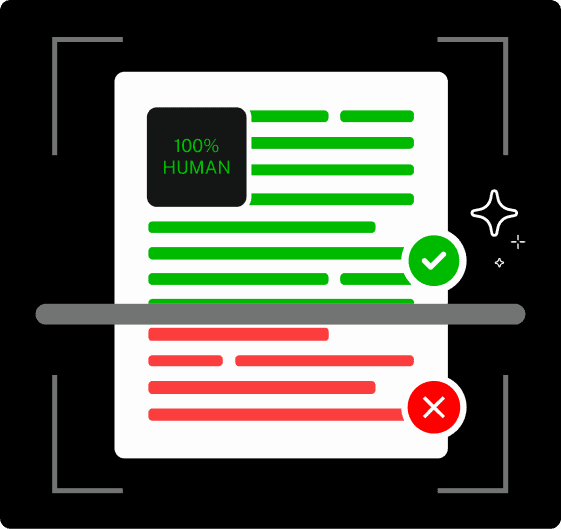
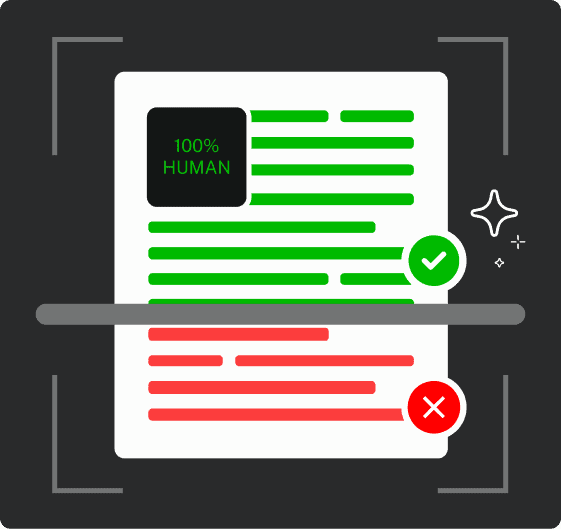
Never Worry About AI Detecting Your Texts Again. Undetectable AI Can Help You:
- Make your AI assisted writing appear human-like.
- Bypass all major AI detection tools with just one click.
- Use AI safely and confidently in school and work.
The reason for starting the essay writing process with an outline is simple: it helps you stay organized.
Essay writing is an overwhelming process, especially when you have lots of ideas to get across.
An outline acts as a guide, helping you figure out the logical flow of your ideas before you start writing.
It ensures your essay has a clear direction, which makes the whole writing process a lot smoother.
There are two common approaches to outlining: formal and informal.
Formal Outline: This is the more traditional method, using Roman numerals (I, II, III) for main sections, and capitalized letters (A, B, C) for subpoints.
It’s a more rigid structure that works well for longer, more complex essays.
For example,
- Introduction
- A. Hook
- B. Background Information
- C. Thesis Statement
- Body Paragraph 1
- A. Topic Sentence
- B. Supporting Evidence
- C. Explanation
Informal Outline: This method is more flexible and simply involves jotting down the main ideas or points you want to cover, often in a bullet-point format.
It’s useful for short essays or when you don’t need as detailed a structure.
For example,
- Introduction: Brief background on climate change
- Causes of Climate Change: Pollution, deforestation
- Effects: Rising sea levels, extreme weather
- Solutions: Renewable energy, conservation efforts
Outlining might seem like an extra step, but it actually saves you time in the long run.
For example,
Let’s say you’re writing an essay on climate change.
Without an outline = You might jump from the effects of climate change to solutions, then back to the causes, which could confuse the reader.
With an outline = You’ll know exactly what to cover and in what order: first introducing the issue, then discussing the causes, followed by the effects, and ending with proposed solutions.
When Should You Use an Essay Outline?
Use an outline before you start writing, especially when your ideas feel messy or hard to explain.
It helps you get clear on what you want to say and the order you want to say it in.
Outlines are most helpful when:
- You’re writing a long or complex essay (like an argument or analysis)
- You have multiple points to organize
- You’re not sure where to begin
Even if you’ve already written a draft, outlining can still help. If your essay feels off, maybe the middle drags or the ending feels rushed, try outlining what you’ve written.
It helps you step back and see what needs to be cut, moved, or rewritten.
Basic Essay Outline Format

Image Source – Medium
Every strong essay starts with a simple plan.
And that plan usually follows three big parts: the introduction, the body, and the conclusion.
- Introduction
A good introduction has three key parts.
- Hook: Add something that grabs attention. It could be a shocking statistic, a quote someone once said, a question that makes the reader think, or even a short story.
- Background Information: Help your reader understand the topic. Give just enough context to set the stage—but don’t overload it.
- Define key terms if needed. For example, “Climate change” refers to long-term shifts in temperatures and weather patterns, mainly caused by human activity.
- Add brief context. For example, This issue has gained global attention over the past few decades, with rising temperatures, sea levels, and natural disasters.
- Thesis Statement: This is the heart of your introduction. One strong sentence that clearly says what your essay will explain, argue, or explore.
- Be direct. Be specific. Avoid vague words like “things” or “stuff.”
- Place it at the end of your introduction to lead into the body paragraphs.
Example (climate change essay):
Climate change is a serious global threat driven by human activity, and in this essay, I will explain how it’s impacting the planet, why it’s accelerating, and what we can do to stop it.
- Body Paragraphs
Now it’s time to get into the heart of your essay.
Include these two key elements in your body paragraphs.
- Topic Sentence: This is the first line of your paragraph, and it should tell what that paragraph is about. Just one main idea.
- Supporting Points: You can use facts, things you’ve read, quotes from experts, numbers, or even your own stories and experiences. They help prove your point.
To hold everything together, use transition words. Words like “Also,” “But,” “Because of this,” or “In contrast.” These words help your writing flow, like a river.
One helpful trick is the PIE method:
- Point – What are you trying to say?
- Illustration – What example or proof do you have?
- Explanation – Why does this matter?
Example (1 paragraph on climate change):
One big cause of climate change is burning fossil fuels. When we drive cars or use electricity from coal, it sends harmful gases into the air.
For example, carbon dioxide traps heat in the atmosphere. This makes the planet warmer. If we don’t stop, weather disasters will become more common. That’s why switching to clean energy is so important.
- Conclusion
The conclusion is where you wrap it all up—but don’t just repeat what you said.
Here’s what you can include in the conclusion outline:
- Start by restating your thesis in a new way. Show how everything connects.
- Sum up your key points from the body paragraphs, like a quick reminder.
- End with a final thought—something that leaves the reader thinking. It could be a lesson, a question, or a call to action (something you want them to do or care about).
Do not add brand-new arguments.
This isn’t the time to start a whole new idea. Just close the loop.
Example (digital learning):
Learning online has changed the way we study. While it gives us freedom and new tools, it also comes with challenges.
We must find ways to stay focused and connected. If we balance tech and real-life learning, we can build a better future for all students.
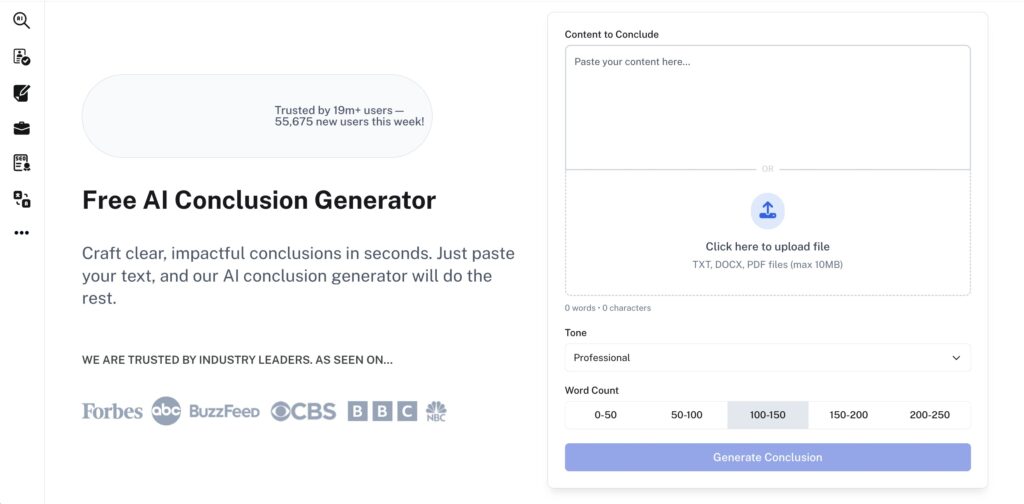
Planning your conclusion early can save you from scrambling for the right words later. That’s why we recommend using our AI Conclusion Generator during the outlining phase — not just at the end.
It helps you frame how your essay will close by restating your thesis, summarizing your key points, and crafting a strong final thought that aligns with your structure.
Whether you’re writing a persuasive, expository, or personal essay, this tool gives you a clear sense of how to wrap things up with purpose — and gives your outline a confident final step.
Essay Outline Templates by Type
Different types of essays require different structures.
Here’s a breakdown of outline templates tailored to each major essay type.
1. Argumentative Essay
An Argumentative Essay is standing up in front of a crowd and saying, “Here’s what I believe, and here’s why it matters.” You give facts, examples, and logic to convince the reader.
Template for Argumentative Essay Outline
- Thesis (Your Opinion)
I believe ______ because ______, ______, and ______.
- Argument 1
First, _______.
For example, _______.
This matters because ______.
- Argument 2
Another reason is _______.
For example, ______.
This shows that _______.
- Argument 3
A third reason is _______.
Here’s an example: ______.
It proves ______.
- Counterargument (The Other Side) + Rebuttal (Why You Disagree)
Some people say ______, but I think ______ because _______.
- Conclusion
In the end, I believe _______ is right because ______, ______, and ______.
If more people understood this, ______.
2. Expository Essay
There’s no opinion here. Just facts, explanations, and answers.
You act like a teacher, showing how something works or why something is important.
Template for Expository Essay Outline
- Introduction
Have you ever wondered _______? In this essay, I will explain ______ by looking at _______, _______, and _______.
- Main Idea 1 (Fact/Explanation)
First, _______. This means _______. A good example is ______.
- Main Idea 2
Next, _______. This helps us understand _______.
- Main Idea 3 (Optional)
Another important thing to know is ______.
- Conclusion
Now you know _______. This topic matters because _______.
3. Narrative Essay
This one feels personal. You write about a moment in your life—something you saw, felt, or experienced.
It has a beginning, a middle, and an end. It shows a lesson, a change, or a feeling you won’t forget.
Template for Narrative Essay Outline
- Setting
It all started when ________. I was in _______, and the time was ______. Everything felt _______.
- Characters
The people in this story were _______. I felt _______ about them because _______.
- Conflict (The Problem)
Then, something happened. _______ went wrong. I didn’t know what to do.
- Climax (The Big Moment)
The biggest moment was when ________. My heart was _______. I had to ________.
- Resolution (The Ending)
In the end, ________. I learned ________. That day taught me ________.
4. Compare & Contrast Essay
This essay helps readers understand something better by comparing it to something else.
You look at both sides side-by-side.
OPTION 1: BLOCK METHOD (All about A, then all about B)
- Introduction
This essay compares ________ and ________. They are alike in some ways and different in others.
- Paragraph on Topic A
First, ________ is ________. It has ________, and it does ________.
- Paragraph on Topic B
On the other hand, ________ is ________. It has ________, and it does ________.
- Conclusion
So while ________ and ________ both _______, they are also different because _______.
OPTION 2: POINT-BY-POINT METHOD (One feature at a time, for both)
- Introduction
In this essay, I will compare _______ and _______ by looking at _______, _______, and _______.
- Point 1: Feature/Idea
Both ________ and _______, _______. However, _______ does it this way, while _______ does it that way.
- Point 2: Another Feature
When it comes to _______, _______ is _______, but _______ is ________.
- Conclusion
In some ways, these two are similar. But they are also different in key ways like _______. Knowing this helps us _______.
Step-by-Step: How to Create an Essay Outline
Here’s the step-by-step way by which you can create an essay outline:
Step 1: Brainstorming Ideas
Before you even start writing, you need to think about your topic.
This step is all about letting your mind run free and exploring what you can say.
- Mind Mapping: Write down your main topic in the center of a page. Draw lines to other ideas that come to mind.
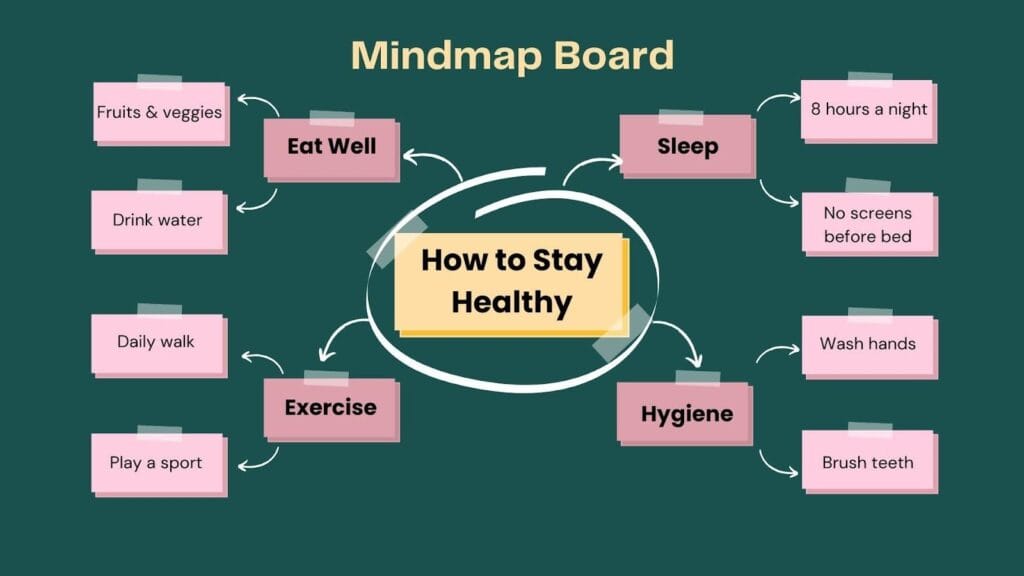
- Freewriting: Set a timer for 10 minutes. Write down everything that comes to mind about your topic—without worrying about grammar or spelling. Just get the ideas out. You’ll sort through them later.
Step 2: Organizing Your Research
Once you’ve gathered some ideas, you need to figure out which ones matter most.
- Organize any research or facts you’ve found. Highlight important details or quotes.
- Group similar pieces of information together so you know which points can go in the same section.
Step 3: Developing Your Thesis
Your thesis statement is the heart of your essay. It’s what you’ll argue or explain.
- Ask yourself: What is the main point you want to make?
- Your thesis should answer the “So what?” question—why does this topic matter?
- Example: If you’re writing about climate change, your thesis might be: “Climate change is real and urgent because it affects weather, wildlife, and human health.”
Step 4: Identifying Main Points
Now, look at your ideas and organize them into main points that support your thesis.
- Ask yourself: What are the key pieces of evidence I want to focus on?
- Main points could be: Facts, statistics, expert opinions, or personal stories.
- For example, for climate change:
- Main Point 1: Effects on weather patterns
- Main Point 2: Impact on wildlife
- Main Point 3: How it harms human health
- Main Point 1: Effects on weather patterns
Step 5: Organizing Your Outline
Time to put everything into an outline.
This is where you organize your points into a hierarchical system (using I, A, 1, a, etc.).
- I. Introduction
- A. Hook
- B. Background information
- C. Thesis statement
- A. Hook
- II. Main Point 1
- A. Supporting details
- B. Example/quote
- A. Supporting details
- III. Main Point 2
- A. Supporting details
- B. Example/quote
- A. Supporting details
- IV. Conclusion
- A. Restate thesis
- B. Summarize main points
- C. Final thought
- A. Restate thesis
Step 6: Balancing Section Lengths
Each section of your essay should be about the same size. Don’t make one section too long and another too short.
How to balance:
- If one section feels too short, add more examples or explanations.
- If one feels too long, break it down into smaller sub-sections.
Step 7: Reviewing and Refining Your Outline
Look over your outline. Does it make sense? Are the points clearly connected?
Ask yourself:
- Does each main point connect back to the thesis?
- Is the order logical?
- Do I need more supporting details?
Step 8: Use AI to Expand Your Outline into Full Paragraphs
Once your outline is ready, you can use an AI Essay Writer to turn your ideas into full paragraphs.
- Input requirements for best results:
- Be clear about your topic and thesis.
- Provide detailed main points and supporting ideas.
- Be clear about your topic and thesis.
- Customization options:
- Choose the tone (formal, casual, academic).
- Pick the style (persuasive, informative, narrative).
- Choose the tone (formal, casual, academic).
- AI Expansion Tip: Start with one section at a time and let the AI help you develop that idea fully before moving on to the next.
How AI Tools Can Help With Essay Outlines
Creating a strong essay outline doesn’t have to be a manual, time-consuming task.
You can use AI tools to clarify your ideas, structure your arguments, and improve flow—faster and wiser.
AI Essay Writer
AI Essay Writer helps you build an outline from scratch by turning a simple prompt into a structured framework.
For best results, be specific with your input.
Instead of: Write an outline on climate change.
Try something like: Create a 5-paragraph persuasive essay outline on how climate change affects U.S. agriculture.
The tool can suggest:
- A logical order for your points
- Expand vague ideas into clear sections
- Ensures each part supports your thesis.
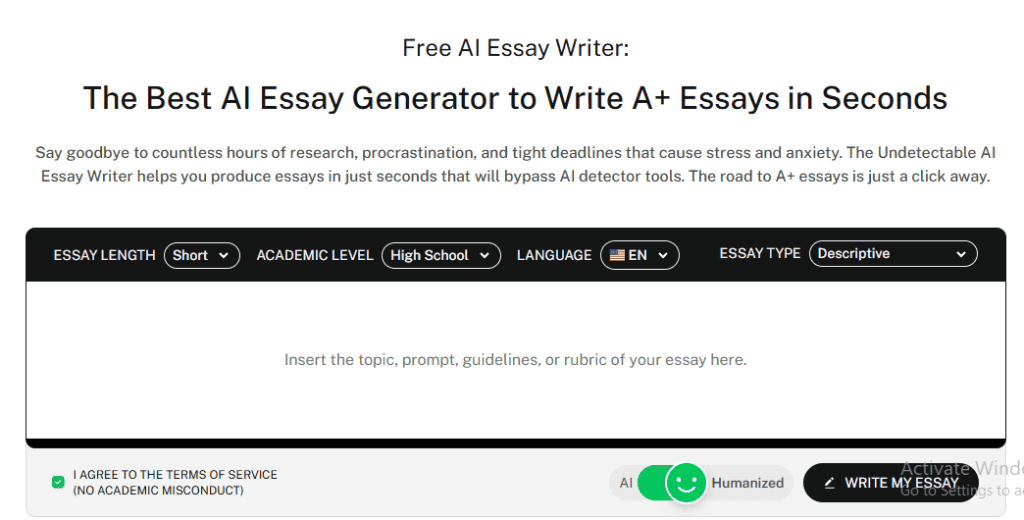
While useful, it’s important to guide the AI—if you’re vague, it may return generic or imbalanced results.
AI Paraphrasing tool
Once you’ve drafted an outline, the AI Paraphrasing tool can help refine awkward or unclear phrasing. It’s useful when your bullet points sound too casual or vague.
For example,
A rough point like “stuff about weather changing” becomes “how rising global temperatures alter seasonal patterns.”
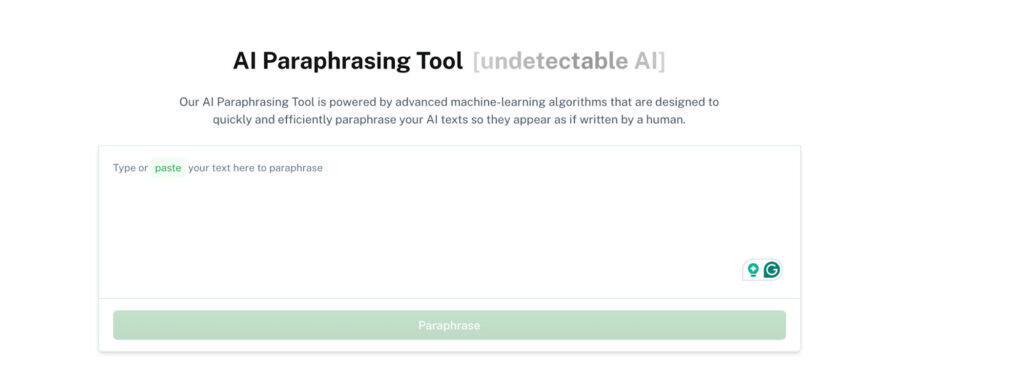
The goal isn’t just to sound smarter—it’s about making sure your outline points set you up for clear, purposeful writing.
AI Chat
When you’re unsure about structure or stuck between options, a conversational AI tool like AI Chatbot can help you think through the outline.
You can ask things like,
- Does this outline make sense for a problem-solution essay?
- Can you help merge these two points without losing meaning?

You can also ask for topic-specific examples or request variations—like converting an analytical outline into a persuasive one.
It’s especially helpful when troubleshooting: if your outline feels repetitive or unfocused, ask the AI to identify gaps or overlaps.
Don’t leave without exploring our AI Detector and Humanizer in the widget below!
FAQs About Essay Outlines
Do I always need an outline?
No, but for complex or long essays, it’s highly recommended.
It keeps your writing focused and prevents missed points.
How detailed should my outline be?
It depends on the assignment.
A short essay might only need a few bullet points, while a research paper needs more structure and detail.
Can I change my outline after starting the essay?
Absolutely. Outlines are flexible tools, not fixed rules. Adjust as your ideas evolve.
How long should an essay outline be?
How long should an essay outline be?
There’s no set length.
It should be long enough to clearly map out your key points and how they connect—nothing more, nothing less.
Conclusion
And there you have it—your brain’s new best friend: the mighty outline.
Whether you’re writing a blog post, drafting a newsletter, or just trying to sort through your ideas—outlines help bring order to the chaos.
They give your thoughts structure, your message clarity, and your process a whole lot more ease.
Here’s a simple challenge: Next time you write anything,create an outline first.
Use a whiteboard, Google Docs, Notion, or plain old pen and paper.
Test out bullet points, mind maps, or sticky notes—whatever helps your ideas flow.
The more you outline, the clearer your writing becomes. The easier it is to start, and the less you’ll want to scream at your screen.
So go ahead—tame that blank page.
